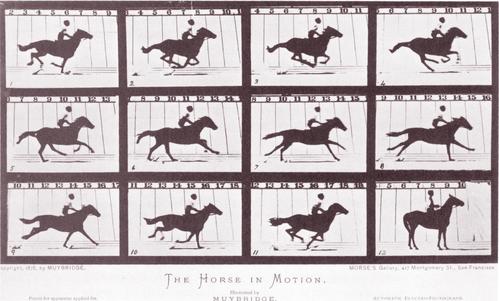LM 8_0 Vectors and motion Collection
Tags | |
UUID | 1f51e73a-f145-11e9-8682-bc764e2038f2 |
8.0 Vectors and motion by Benjamin Crowell, Light and Matter licensed under the Creative Commons Attribution-ShareAlike license.

Chapter 8. Vectors and motion
In 1872, capitalist and former California governor Leland Stanford asked photographer Eadweard Muybridge if he would work for him on a project to settle a $25,000 bet (a princely sum at that time). Stanford's friends were convinced that a galloping horse always had at least one foot on the ground, but Stanford claimed that there was a moment during each cycle of the motion when all four feet were in the air. The human eye was simply not fast enough to settle the question. In 1878, Muybridge finally succeeded in producing what amounted to a motion picture of the horse, showing conclusively that all four feet did leave the ground at one point. (Muybridge was a colorful figure in San Francisco history, and his acquittal for the murder of his wife's lover was considered the trial of the century in California.)
The losers of the bet had probably been influenced by Aristotelian reasoning, for instance the expectation that a leaping horse would lose horizontal velocity while in the air with no force to push it forward, so that it would be more efficient for the horse to run without leaping. But even for students who have converted wholeheartedly to Newtonianism, the relationship between force and acceleration leads to some conceptual difficulties, the main one being a problem with the true but seemingly absurd statement that an object can have an acceleration vector whose direction is not the same as the direction of motion. The horse, for instance, has nearly constant horizontal velocity, so its `a_x` is zero. But as anyone can tell you who has ridden a galloping horse, the horse accelerates up and down. The horse's acceleration vector therefore changes back and forth between the up and down directions, but is never in the same direction as the horse's motion. In this chapter, we will examine more carefully the properties of the velocity, acceleration, and force vectors. No new principles are introduced, but an attempt is made to tie things together and show examples of the power of the vector formulation of Newton's laws.
8.0 Vectors and motion by Benjamin Crowell, Light and Matter licensed under the Creative Commons Attribution-ShareAlike license.
Calculators and Collections
- Comments
- Attachments
- Stats
No comments |
